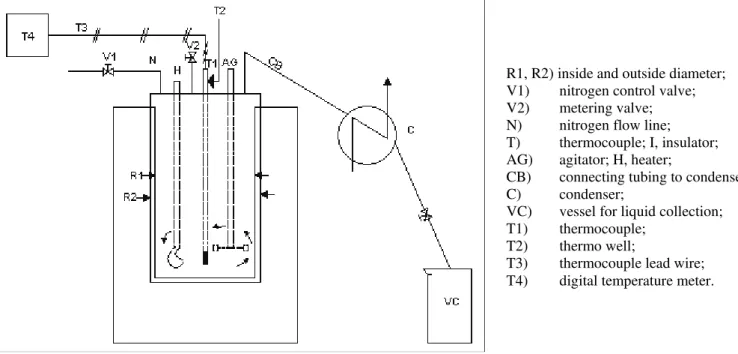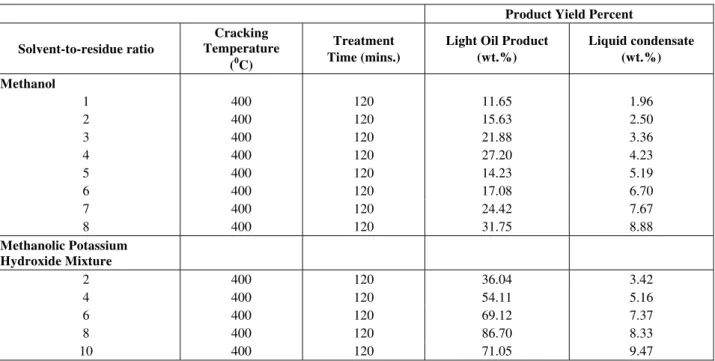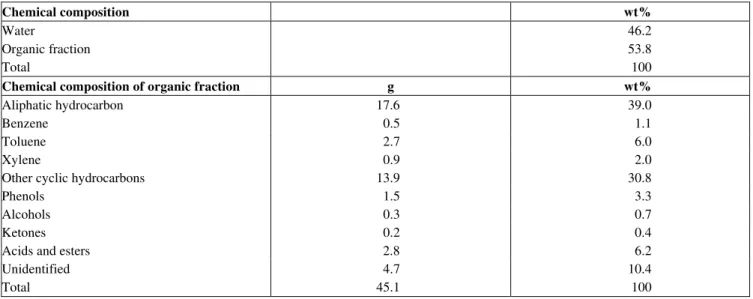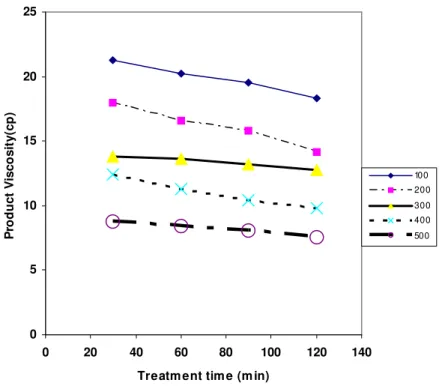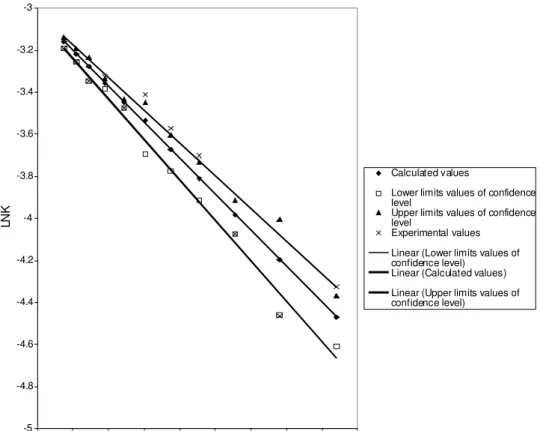ISSN 0104-6632 Printed in Brazil
www.abeq.org.br/bjche
Vol. 23, No. 03, pp. 331 - 339, July - September, 2006
Brazilian Journal
of Chemical
Engineering
EFFECTS OF OPERATING CONDITIONS ON
COMPOSITIONAL CHARACTERISTICS
AND REACTION KINETICS OF LIQUID DERIVED
BY DELAYED COKING OF NIGERIAN
PETROLEUM RESIDUE
O. O. Bello
1*, B. T. Ademodi
1, S. R. A. Macaulay
1and G. K. Latinwo
21Department of Chemical Engineering, Obafemi Awolowo University, Ile-Ife, Nigeria. 1
Institute of Petroleum Engineering, Technische Universität Clausthal, Fax: +(49) 5323 72-3146, Agricolastraße 10, 38678 Clausthal-Zellerfeld, Germany
E-mail: oladele.bello@tu-clausthal.de
2
Department of Chemical Engineering, Ladoke Akintola University of Technology, Ogbomoso, Nigeria.
(Received: May 10, 2005; Accepted : April 5, 2006)
Abstract - The thermal upgrading of Nigerian petroleum residue was studied at relatively low pressure in a delayed coking reactor system. In this work, the intent was to investigate the effects of process variables such as reaction temperature (2000C to 6000C), reaction time (0 to 120min), additive concentration loading and additive-to-residue ratio on the amounts and quality of organic liquid product (OLP). The liquid products derived from the delayed coking process were characterized by means of instrumental analysis of gas-liquid chromatography. Results obtained from the analyses of the OLP revealed an upward trend of the conversion process and the selectivity of the aromatic compounds with additive-to-residue ratio (ARR) and increase in temperature. This led to maximum yield of 37.2% achieved with ARR of 5 compared to 31% achieved with ordinary thermal conversion. The selectivity for aromatic hydrocarbons was maximum at 83.1wt% the selectivity towards aromatics and aliphatic hydrocarbons were highest for methanol-potassium hydroxide and methanol respectively. In all additive system cases, maximum OLP was produced at an optimum reaction temperature of 3700C in the delayed coking reactor and at higher residence time. The gaseous product consisted of carbon monoxide and carbon dioxide and C1 – C6 hydrocarbons, which amounted to about 20 to
30 wt% of liquid distillate. The information obtained in this study show that the organic liquid products are amenable to characterization procedure and provided the basis for the identification of processes for upgrading Nigerian petroleum residue and such other starting materials such as bitumen or fossil fuel coal liquids
Keywords: Petroleum residue; Delayed coking; Product distribution; Nigeria.
INTRODUCTION
There has been continued interest in the exploitation of the world’s petroleum residues for reasons related to both economic and market forecasts as well as reasons of national interest to
accomplish this upgrading. Catalytic upgrading of the residue is necessarily more expensive because of the higher catalyst and hydrogen consumptions. In general, some hydro-processing will be required to eventually produce finished products but the high investment and operating costs of hydro-processing can be mitigated by the introduction of non-catalytic processes to upgrade residues [Bello, et. al., 2001]. Among the upgrading processes, delayed coking is more important because of its low investing and operating costs, broad feed stock applicability and high conversion [Elliot, et. al., 1981]. Delayed coking is a severe form of thermal cracking in which the viscosity and pour point of the liquid hydrocarbon base material is permanently reduced after it has been subjected to severe temperature for a period of time at comparatively low pressure under inert condition.
Several investigators Jiazhi, et. al., 2002a; Zacheria, et. al., 1982; Bonila, 1982; Jiazhi, et. al., 2002b] have reported the results of deasphalting and thermal conversion of Athabasca oil sands, Arabian heavy crude, Orinoco heavy crude, Lloydminster heavy oil, Loda (Nigeria) tar sand and Marguerite lake bitumen as feedstock under variety of operating conditions. Since the petroleum residue characteristics vary drastically from one region to another, delayed coking application problems and solutions also vary. Process conditions that are effective in one system are not always successful in others because most applications are those developed for tar and oil sand bitumen and not from petroleum derived fluids or petroleum based fractions.
While the issue of delayed coking upgrading has been addressed by numerous studies [Bello, et. al., 2001; Ukwuoma, 1993; Elliot, et. al., 1981; Schucker, 1983; Zacheria, et. al., 1982; Bonila, 1982; Jiazhi, et. al., 2002b], information relating delayed coking product spectrum to Nigerian petroleum residue characteristics is not available. Such information could foster design concepts and optimization strategies for utilizing a vast accumulation of petroleum residues in all the nation’s refineries. The present work tries to provide a better description of the conversion of Nigerian petroleum refinery residue to synthetic fuels and chemicals using delayed coking reactor system at various operating conditions. The effect of process variables such as temperatures, reaction time and chemical additives on the organic liquid product (OLP) yield and kinetics was studied.
MATERIAL AND METHODS
The vacuum residue of Nigerian medium gravity crude was used in this study. The physical properties of the residue are given in Table 1. Detailed procedures for characterizing the residue has been reported elsewhere [Bello, et. al., 2001].
The experimental aspects of the present study consist essentially of (a) thermal conversion of the residue with methanol-potassium hydroxide and methanol followed by (b) chromatographic analysis of the samples of the products obtained from the thermal upgrading experiments.
Table 1: Physical properties of Nigerian Petroleum Residue [Bello, et. al., 2001]
Physical Properties Values
Gravity, API 11.9
Viscosity, cS (mm2/s) at 1000C 526.8
Sulphur, wt. % 0.3
Conradson carbon residue, wt. % 16.0
Pour point, 0C 41.0
Viscosity index 131.1
Viscosity gravity constant 0.9
Vanadium, ppm 1.9
Nickel, ppm 15.0
Equipment and Experimental Procedure
The thermal conversion of the petroleum residue was studied in a delayed coking reactor system with additive concentration and additive-to-residue ratio been varied. The system is comprised of the following components; reactor and transport, a
held in place by a flange of 80mm outside diameter with 19.1mm thickness. The annulus consists of an electric heater capable of heating the feed sample to the desired temperature. Here, under precise temperature control, the desired sample cracking can be achieved. The carrier gas, which is nitrogen gas, transports the cracked sample to the shell and tube condenser. It has been demonstrated that the residence in the reactor does not vary by more than ±10% [Jiazhi, et. al., 2002a]. The reactor is capable of being operated at temperatures of up to 600oC and at residence time of 0 to 120 minutes. The products of thermal conversion are cooled in a shell and tube condenser, collected, characterized and analyzed using analytical equipment. The schematic diagram of the experimental setup is shown in Figure 1.
The experimental runs were carried out at low pressure in a batch reaction system operated within the temperature range of 200-6000C and residence time of 30 to 120 minutes. In a typical run, the
petroleum residue was fed into delayed coking reactor. Prior to delay cooking conversion process, the Nigerian refinery fuel oil was purged with nitrogen in the reactor for 10 minutes to remove residual oxygen. The Nigeria refinery fuel oil was heated at 8000C/s to reaction temperatures between 100 and 6000C and maintained at that temperature for 30 to 120 minutes. Using a shell and tube condenser, the resulting gaseous product stream was condensed and colleted in a vessel. At the conclusion of each run, the yields were measured. For some experiments, the Nigerian residue samples charged into the reactor was dosed with varied amounts of methanol and alcoholic potassium hydroxide loading and additive-to-residue ratio. A T-shaped agitator was used to achieve proper mixing during reaction to ensure uniformity of reaction. The procedure was repeated for every 30 minutes, until the total residence time for each isothermal operation was 120 minutes. The gaseous product steam was passed through a condenser and the liquid product collected.
Figure 1: Schematic diagram of the experimental apparatus
Product Analyses
The liquid product had a single homogeneous phase, and a few of these product samples were distilled at 2000C and 172 Pa using a Buchi GKR-56 distillation unit. No residue was observed after this distillation. This shows that substantial cracking of the non-volatile fraction of the petroleum residue had occurred during the upgrading process. Therefore, all other liquid
products were directly analyzed by a gas chromatography (Carle GC-500) with a banded non-polar (methyl silicone) 50m x 0.2mm i.d. capillary column and a flame ionization detector (FID). The compounds present in the liquid product were identified by using standard compounds and by GC-MS (Finningan/MAT-4500). The total weight of each component class of the distillate was determined from the percentage of each component class in the total products collected.
R1, R2) inside and outside diameter; V1) nitrogen control valve; V2) metering valve; N) nitrogen flow line; T) thermocouple; I, insulator; AG) agitator; H, heater;
CB) connecting tubing to condenser; C) condenser;
VC) vessel for liquid collection; T1) thermocouple;
T2) thermo well;
RESULTS AND DISCUSSION
Thermal Upgrading of the Petroleum Refinery Fuel Oil in the Delayed Coking Reactor
The petroleum residue samples were tested on the apparatus and delayed coking tests were performed for each petroleum residues at eight reaction temperatures (250, 300, 350, 450, 500, 550, and 600oC). The results reported here are averages of a minimum of four tests performed per petroleum residues at each reaction temperature. The product yields are listed in Table 2. The product yields from tests performed at 4000C temperature were repeatable as illustrated by the standard deviation of the measured light oil given in Table 2. The standard deviation was between 0.2 and 4.0% and was generally less than 2.0%. Approximately 0.5% of this variation may be due to the accuracy of the balance used to determine the yields.
Experiments were carried out also to study the characteristics of solid and liquid products obtained from eleven samples of petroleum residues with
different properties (specific gravity, apparent viscosity, pour point, sulfur content, etc) were used as feed. Various physical characteristics of the liquid product obtained during the thermal treatment of petroleum residues are also presented in Tables 2 and 3. A comparison of the physical properties of whole petroleum residues and liquid product derived from thermal upgrading of petroleum residues shows that the viscosity and density of liquid product were lower than those of the original petroleum refinery fuel oil. Chemical composition of the liquid product obtained during thermal treatment of petroleum residues is presented in Table 4. The liquid product consisted of 49.1 wt% aliphatic hydrocarbons, 23.5 wt% aromatic hydrocarbons, and 12.4 wt% naphthenic hydrocarbons, apart from minor fraction of phenols, ketones, alcohols, acids and esters. For a given treatment time, the two products yields increased with treatment temperature, the results are shown in Figures 2 and 3. The observed trend of the yield showed that increasing the treatment temperature and time might increase the yield of the two products.
Table 2: Methanol and Methanolic Potassium Hydroxide mixture Thermal conversion yields as a function of Temperature (4000C) and Time (120 min)
Product Yield Percent
Solvent-to-residue ratio
Cracking Temperature
(0C)
Treatment Time (mins.)
Light Oil Product (wt.%)
Liquid condensate (wt.%)
Methanol
1 400 120 11.65 1.96
2 400 120 15.63 2.50
3 400 120 21.88 3.36
4 400 120 27.20 4.23
5 400 120 14.23 5.19
6 400 120 17.08 6.70
7 400 120 24.42 7.67
8 400 120 31.75 8.88
Methanolic Potassium Hydroxide Mixture
2 400 120 36.04 3.42
4 400 120 54.11 5.16
6 400 120 69.12 7.37
8 400 120 86.70 8.33
Table 3: Change in the Viscosity, Density, API gravity and Pour Point of the derived liquid products from the Nigeria Petroleum Residue with Treatment.
Temperature and Time
Treatment of the Product Viscosity of the
product
Density of the product
API gravity of the product
Pour point of the product
Run No. Temperature
(0C)
Treatment time
(Mins.) (cp.) gm/cm
3
(0API gravity) (0C)
1 100 30 51.28 0.936 19.70 24.3
2 100 60 42.23 0.925 21.47 25.02
3 100 90 39.56 0.910 24.00 26.15
4 100 120 31.33 0.891 27.30 27.80
5 200 30 29.33 0.862 32.65 28.19
6 200 60 27.59 0.837 37.56 29.22
7 200 90 25.83 0.818 41.48 30.54
8 200 120 23.11 0.794 46.71 31.10
9 300 30 21.84 0.786 48.50 32.35
10 300 60 20.66 0.773 51.60 32.69
11 300 90 18.18 0.764 53.71 33.11
12 300 120 15.70 0.752 56.61 34.46
13 400 30 12.40 0.744 58.69 35.36
14 400 60 11.27 0.731 62.07 36.47
15 400 90 10.43 0.725 63.70 38.12
16 400 120 9.78 0.720 65.03 38.67
17 500 30 8.73 0.703 69.78 39.41
18 500 60 8.42 0.695 72.10 41.25
19 500 90 8.10 0.689 73.87 41.80
20 500 120 7.57 0.684 75.37 42.22
Table 4: Chemical composition of the liquid product obtained from Thermal treatment of Nigerian Petroleum Residue
Chemical composition wt%
Water 46.2
Organic fraction 53.8
Total 100
Chemical composition of organic fraction g wt%
Aliphatic hydrocarbon 17.6 39.0
Benzene 0.5 1.1
Toluene 2.7 6.0
Xylene 0.9 2.0
Other cyclic hydrocarbons 13.9 30.8
Phenols 1.5 3.3
Alcohols 0.3 0.7
Ketones 0.2 0.4
Acids and esters 2.8 6.2
Unidentified 4.7 10.4
Total 45.1 100
0 5 10 15 20 25 30 35 40 45
0 20 40 60 80 100 120 140
Treatment time (min)
Pr
oduct
Yi
e
ld
100 150 200 250 300 350 400 450 500 550 600
Figure 2: Effect of treatment time and temperature on product yield
0 5 10 15 20 25
0 20 40 60 80 100 120 140
Treatm ent tim e (m in)
P
roduc
t V
is
c
o
s
it
y
(c
p)
100 200
300 400 500
Effects of Additive System and Additive-to-residue ratio on Product Characteristics and Reaction Kinetics
The relative proportions of the products spectrum obtained from with the use of methanol and methanolic potassium hydroxide mixture at various solvent-to-residue ratios used are as shown in Table 4. For the two additive systems, the percentage of the aromatic compounds increase with increasing ARR. However, the percentage is higher at every stage obtained with methanolic potassium hydroxide mixture than in the methanol system. This may be due to the fact that these chemicals had undergone cracking reaction involving rupture of carbon-carbon bonds yielding lighter hydrocarbons However, since an aliphatic content of less than 40.0wt% was reported for the petroleum residue used [Bello, et. al., 2001], the trend should be attributable to methanol enhancing effect involving the capture of carbon species by free radical created during the delayed coking reaction. The high yield of aliphatic hydrocarbons in the presence of methanol and potassium hydroxide strongly indicate these additives to be promoters of the cracking reaction. This might be due to the fact that there was increased reaction due to addition of methanolic potassium hydroxide aiding decomposition of petroleum residue sample.
It might also be due to the fact that alcohol and potassium hydroxide provide the opportunity for chemical reaction during the conversion because of the nucleophilicity of the alcohol hydroxyl group and the tendency of the alcohol to act as a hydrogen donor. It is thought that such methanol enhancing effect may involve the capture of carbon species by free radial created during the delayed coking cracking reaction. This results in the return of more cracked liquid reactant fraction to the vapor phase. Thus, the methanol gives a higher percentage of aromatic hydrocarbons than methanolic potassium hydroxide, probably due to its greater selectivity towards aromatics. The results of feed conversion and distillate yields as functions feed properties, varied methanol and potassium hydroxide concentrations and ARR at reactions temperatures and time of 400oC and 120 minutes respectively are as presented in Table 4.
In the absence of methanol the yield of coker distillate increased as coking temperature was increased from 100oC to 500oC, at 250oC no appreciable change in the yield of coker distillate was observed for petroleum residue samples containing up to 5 percent methanol.
Figures 4 shows the result of kinetic analysis of the process reaction, with the conversion for given reaction temperatures and concentrations plotted as a functions of time. The degree of the conversion reaction was observed to depend on the reaction concentration and temperature. The higher conversion from the progress of reaction plots is that observed when 24% methanol was added. Figure 4 also shows the effect of initial concentration of methanol on the rate of conversion of the petroleum residue to hydrocarbons. As can be seen, the methanol has relatively high effect on the overall conversion process. It is thought that such methanol enhancing effect may involve the capture of carbon species by free radical created during the delayed coking reaction. This results in the return of more cracked liquid reactant fraction to the vapor phase. The reaction rate data obtained in this study were analyzed using first-order reaction model. This model is the one which best fits the result of previous workers for the kinetics of heavy oil conversion process. The present study confirms this mechanism. Arrhenius plots for the rate constants obtained from the least-square regression applied to the database is shown in Figure 4. Activation energy of 24.5Kcal/mol was obtained. Efficiency of the petroleum residues thermal process increase with the increase in temperature and initial potassium hydroxide concentration. A conversion process efficiency of 70% was achieved at operating
temperature of 500oC, 24% methanol and 0.6M
-5 -4.8 -4.6 -4.4 -4.2 -4 -3.8 -3.6 -3.4 -3.2 -3
0.001 0.0012 0.0014 0.0016 0.0018 0.002 0.0022 0.0024 0.0026 0.0028
1/T (Reciprocal deg. K)
LN
K
Calculated values
Lower limits values of confidence level
Upper limits values of confidence level
Experimental values
Linear (Lower limits values of confidence level)
Linear (Calculated values) Linear (Upper limits values of confidence level)
Figure 4: Arrhenius plot for the constant of model equation at 24% V/V Me OH + 0.6M KOH
CONCLUSIONS
The exploratory study of upgrading Nigerian petroleum residue in a delayed coking reaction system has indicated that it is practical to produce high quality liquid products by delayed coking of the petroleum residue at high temperature and low pressure with chemical additives. Results obtained from the experimental work shows that operating temperature, residence time, additive concentration loading and additive-to-residue ratio have important influence on the efficiency of petroleum residue to fuels and chemicals. The OLP and aromatic hydrocarbon selectivities followed the order methanolic potassium hydroxide > methanol > no additive. High OLD and aromatic hydrocarbon selective for methanol – potassium hydroxide were due to methanol enhancing effect involving the capture of carbon species by free radical created during the delayed coking reaction.
The OLP yield was maximum at 350oC and a
maximum fraction of 83 wt% of OLP consisted of aromatic hydrocarbons using two
methanol-potassium hydroxide at optimum reaction temperature and a residence time of 2 hours. The OLP obtained without methanol additive consisted of a higher fraction of aliphatic hydrocarbons whereas that with methanol-potassium hydroxide mixture contained more aromatic hydrocarbons. The OLP yield was approximately ¼ of the petroleum residue with 83wt% selectively for aromatic hydrocarbons. Higher residence time was desirable for high OLP yield in all the three thermal conversion cases. Therefore, it is recommended that an evaluation of this process under continuous mode may be performed.
REFERENCES
Bello, O. O., Macaulay, S. R. A., Layokun, S. K. and Ademodi, B., Synthetic Fuel Production from the Nigerian Refinery Fuel Vacuum residues. African Journal of Science and Technology. Vol. 2 (No. 1 and 2), pp. 208-212 (2001).
Technology International, Vol. 11 (No. 11), pp. 1629 (1993).
Bonila, J. A., Delayed Coking and Solvent Deasphalting: Options for Residue Upgrading. A.I.Ch.E. National Meeting, Anaheim, California, USA, June (1982). Jiazhi, X., Lanjuan, W., Qinglin, C. and Daoming,
W., Modeling for Product Distribution in Thermal Conversion of Heavy oil. Petroleum Science and Technology, Vol. 20 (No. 5 & 6) pp. 605-612 (2002a).
Jiazhi, X., Lanjuan, W., Qinglin, C. and Antai, S., Experimental Verification for Process Modelling of Coking Heater Inner Tube, Petroleum Science
and Technology, Vol. 20 (No. 5 & 6) pp. 613-620 (2002b).
Elliott, J. D., Godino, R.L. and McGrath, M. J., Non-Catalytical Heavy Crude Upgrading. Third UNITAR Conference on Heavy Crude and Tar sands, pp. 1147-1156 (1981).
Schucker, R. C., Thermo gravimetric Determination of the Coking Kinetics of Arabian Heavy Vacuum Residuum. I&EC Process Design and Development, Vol. 22, pp. 615 (1983).
![Table 1: Physical properties of Nigerian Petroleum Residue [Bello, et. al., 2001]](https://thumb-eu.123doks.com/thumbv2/123dok_br/18894093.425862/2.892.211.687.798.965/table-physical-properties-of-nigerian-petroleum-residue-bello.webp)
